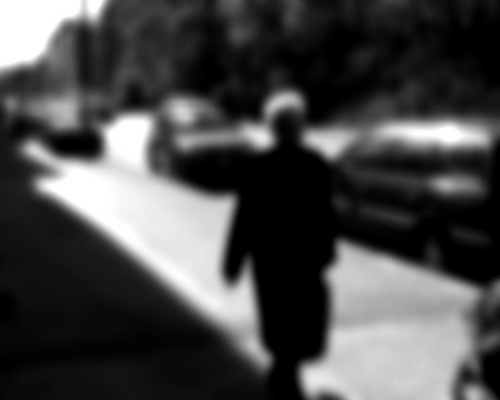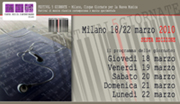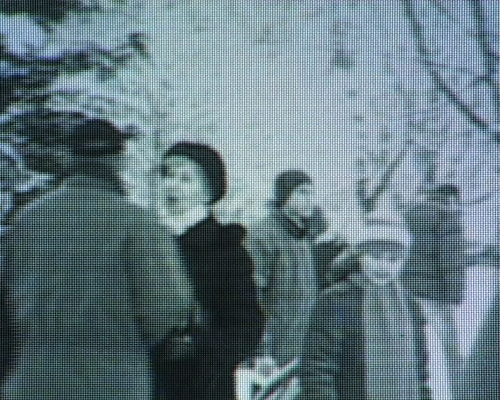 “Where am I when I go to Heaven? It’s all a farce, it’s an invention of these crooks, of these jerks…the shit stays here, the soul goes to Heaven… do you believe in Heaven? Do you really believe in such bullshit?”
“Where am I when I go to Heaven? It’s all a farce, it’s an invention of these crooks, of these jerks…the shit stays here, the soul goes to Heaven… do you believe in Heaven? Do you really believe in such bullshit?”
Mieczeslaw Krajczewski, 1928/2007
Festivals | Sinossi | Sezioni | Crediti | Scrivere… | Video
Festivals e Rassegne
 STRASBOURG INTERNATIONAL FILM FESTIVAL – Nomadic Tendencies 2010
STRASBOURG INTERNATIONAL FILM FESTIVAL – Nomadic Tendencies 2010
 GLOBIANS DOC FEST BERLIN – 2010
GLOBIANS DOC FEST BERLIN – 2010
![]()
Lucca, 8 MINUTI DAL SOLE, 1 MINUTO DALLA LUNA – L’Immagine del Suono 2010
 URBAN NOMAD – Video-Art Exhibition 2010
URBAN NOMAD – Video-Art Exhibition 2010

FESTIVAL 5 GIORNATE 2010 – Milano, Cinque Giornate per la Nuova Musica
![]()
CINEMAVVENIRE VIDEO FESTIVAL 2010 – Roma
 Lucca, Circolo del Cinema, 1 Marzo 2010
Lucca, Circolo del Cinema, 1 Marzo 2010
 CAMBOFEST 2009 (URBAN KNOTS) – Official Selection
CAMBOFEST 2009 (URBAN KNOTS) – Official Selection
Synopsis
THE WALBRZYCH NOTEBOOK is a sort of anthropological portrait of the Polish town of Walbrzych, a former mining site active until the 90s; after a period of crisis, due to the closing of the mines and the consequent firing of hundreds of workers, the city starts today to show some signs of renewal. The film focuses on spaces and people moving inside this reality, it explores the effects, but avoids any kind of historical or scientific speculation on what has happened; more than a real documentary, the film looks like a painter’s draft book, a representation of a place and a time, filtered by the eyes and the ears of a visual-sound artist. In fact the film is conceived like a sort of music composition, a score combining natural sounds, speeches, instrumental music, as well as images.
The film, divided into several episodes, some of which can be considered as authonomous standalone movies, includes excerpts from the two previous videos Czarna Madonna (2004/2005) and Four Studies On Location And People (2005/2008).
As the previous Chiayi Symphony (2006/2007), The Walbrzych Notebook can be considered a sort of visual-sound diary; everyday life sequences are reinterpreted as pure actions and tranformed into surrealistic paintings melted down into a sort of long audio-visual stream-of-consciousness; the soundtrack, scored for electric guitar, natural sounds, wind and percussion instruments, strongly contributes to move the film on the oneiric level. The final result is an anthropological representation of a labirynth where from time to time people’s private actions and stories rise up to become universal. A meditation about action, stasis, doing and undoing, environment, daily rites and religious trust.
The Walbrzych Notebook stays halfway between a documentary and a video-art project, an extended music composition and a sound-image performance. Entirely produced by S.G. the film is his first feature.
Sections
The Testament (Part 1)
Zofia is at home, alone; she is knitting and wondering. Then she starts a long slow trip to the graveyard where Mieczyslaw, her husband, is buried; Mieczyslaw’s voice-off holds an intense monologue against priests and church. The landscape changes from springtime to winter.
Urban Knots
Some images of the streets of Walbrzych are overlapped in an odd compositive game. A long trip by car in black and white. The same streets at night time. City as a knot of spaces and directions.
Visiting Families A video puzzle of footage shot while visiting families. Drinking, chatting, eating. Old Polish traditional songs accompany the game.
The Box A couple of interviews to Jurek and Ewa, an elder man and his wife, about their past lives, are interpoled by a surreal sequence describing Jurek’s walk to an old mausoleum on the hills around the city of Walbrzych. A bird breaks a net and flies away freely from the mausoleum. Music for electric guitar, percussion and winds.
Tourist Guide – Michal, a boy 13 years old is the youngest tourist guide in Poland. He speaks about Walbrzych and leads us touring into the city: the old market square, today restored, the coal deposit area, the Church of Angels etc.
Trust – A priest sings the old Polish song Czarna Madonna re-arranged as a pop song and interpreted in a surrealistic tv-recital atmosphere. An army of priests in uniform celebrate the catholic mass in pomp of colours. The picture slowly detunes as in an old tv, and dissolves into a bundle of electric waves.
Return Ticket – A slow and hypnotic endless winter trip by train from a big city (Wroclaw) to Walbrzych. A subjective walk through the old centre of Walbrzych, not yet restored, reveals a sort of post-industrial desolated landscape, made of fatiscent palaces; the camera moves like an eye exploring a deserted labyrinth, underlined by a soundtrack made of foot steps in the snow, ice sounds, objects falling down. Then the trip back by train. Little stations, snow landscapes, passengers’ thoughtful faces slide away like a film on a screen. To arrive again, like in a hallucination, to Walbrzych.
The Testament (Part 2) – Winter time. Zofia visits Mieczyslaw in the graveyard. Mieczyslaw goes on with his monologue against the church. Zofia cleans the tomb; suddenly it is springtime. Mieczyslaw asks where he goes when he is in Heaven. Zofia slowly goes away from the graveyard on her husband’s final existential question: “Do you really believe in such bullshit?”
Credits
THE WALBRZYCH NOTEBOOK
Length: 71’30” min.
Languages: Polish, German (with some Italian and English)
Subtitles: English, Italian
Subject and direction: Stefano Giannotti
Director’s assistants: Mariola Krajczewska and Matilde Giannotti
Interpreters: Zofia and Mieczyslaw Krajczewscy, Ewa and Jerzy Krajczewscy, Joanna and Zuzka Wuszczynski, Michal Machowski and other inhabitants of the Polish town of Walbrzych
Director’s Assistants: Mariola Krajczewska and Matilde Giannotti
Original music composed and produced by Stefano Giannotti and some traditional Polish Songs(Public Domain)
Stefano Giannotti: electric guitar, radio-waves, Revox tape-recorder, field recordings and treatments.
Translations by: Mariola Krajczewska, Annalisa Pace (Studio Lucca Traduce), Stefano Giannotti,Lia Stefani, Gina Stefani
Special Thanks to: Maria Teresa Elena, Giacomo Verde, Andreas F. Müller, Ullabritt Horn, Mariola Krajczewska for their precious support
Special Thanks also to: Jerzy Wuszczynski, Alina and Janusz Borcon, Gabi and Lilka Lukomska, Joanna Oleszek, Domenico Trubiano and Bruno Fiorino
Produced by Stefano Giannotti, between 2004 and 2009 with the support of friends and relatives
© Copyrights by Stefano Giannotti
All Rights Reserved
Scrivere con il tempo (only in Italian at the moment)
di Giacomo Verde
THE WALBRZYCH NOTEBOOK si basa su riprese che Stefano ha fatto nel corso di sei anni… tutto nasce da riprese familiari, perché i protagonisti sono parenti e amici di Stefano; l’intero film è ambientato in Polonia, cioè racconta di un paese polacco, di una cittadina; nasce però in modo diverso da quello di un normale film, non si basa su di una trama, non ci sono attori che recitano, ma ci sono persone riprese dalla telecamera, filmate non da un normale video-maker, ma da un musicista… l’opera nasce dunque in un ambito di creazione audiovisiva che è molto legato a quello della creazione della video-arte, più che della fiction o del documentario.
Molti video-artisti, prima di diventare tali, erano musicisti; Bill Viola stesso, che è quello più famoso di tutti era un musicista, ma anche Nam June Paik, che è un altro dei padri fondatori della video-arte nasce come musicista… quindi è molto bello, giusto e corretto vedere che Stefano, che prima di tutto è un musicista, sia passato anche lui a fare video; THE WALBRZYCH NOTEBOOK non segue quelle che sono le regole classiche della sceneggiatura e della scrittura filmica, ma osserva piuttosto le regole della composizione musicale; è come se, invece di scrivere nel tempo, come normalmente si fa con i film, Stefano scrivesse con il tempo… cioè come scrive un musicista; infatti è un’opera questa, oltre che da vedere, da sentire…
Noi viviamo in una civiltà delle immagini, ma in realtà le immagini non significano niente… ci viene continuamente fatto credere che le immagini siano importanti e che tutto ciò che ci circonda si basi sulla comunicazione per immagini; questa è una bugia, perchè le immagini di per sé non significano nulla; le immagini acquistano significato a seconda del contesto in cui sono inserite e quindi assumono un valore piuttosto che un altro; e questo lavoro di contesto, di generazione di contesto per creare significato è quello che Stefano ha fatto nel suo video, utilizzando l’esperienza del campo musicale; uno dei modi per creare contesto, per dare significato alle immagini è creare una colonna sonora; a seconda della colonna sonora una qualsiasi sequenza cambia completamente di senso, di significato, di stati d’animo; in questo film la colonna sonora non è una semplice colonna sonora; essa nasce veramente insieme alle immagini, dà senso alle immagini…
Mi verrebbe da pensare che il film somiglia più ad una specie di LP visivo; un concept album come all’epoca dei Genesis e dei Pink Floyd… nei concept album si componevano canzoni, ma queste erano tutte collegate tra di loro… è lo stesso lavoro che ha fatto Stefano in questo film; sono otto episodi, tutti collegati tra di loro attraverso accostamenti tematici, e non semplicemente narrativi; per cui ogni episodio ha in realtà una sua autosufficienza, come un brano musicale che vive di luce propria, ma che collegato assieme agli altri crea un grande affresco, un grande disegno, dove si racconta di questa città.
L’altra cosa molto interessante è che questa città è rappresentata non veramente o soltanto dall’architettura come normalmente ci verrebbe da pensare, ma è raccontata da alcuni abitanti, da alcuni protagonisti, i parenti, che diventano simbolo di un qualcosa che va aldilà del proprio quotidiano; una ripresa familiare, quotidiana, se trattata, rielaborata da un occhio, da una mano intelligente, può diventare rappresentativa di un mondo, ed andare aldilà del proprio personale; perchè comunque, tutto ciò che è il nostro personale quotidiano in realtà non è mai solo nostro, ma è qualcosa che si colloca in una storia, in un contesto sociale, politico ed emotivo; dunque, mi ha toccato molto vedere come delle storie personali, anche banali per certi versi, riescano a fotografare una realtà che diventa poesia, oltre che musica.
Dal discorso di presentazione al Circolo del Cinema di Lucca, Complesso di San Micheletto, 1 Marzo 2010
Video
Urban Knots
The Box



